Course Material of ESDP on Food Processing in Hindi + English
Course Material of ESDP on Food Processing in Hindi + English Course Material of ESDP on Food Processing in Hindi + English
MANAGEMENT OF SMALL ENTERPRISESThe goal
provides springboard from the present. The elements
- Page 3 and 4: m|ferk ,oa m|eh ds xq.kvkids izR;sd
- Page 5 and 6: 11. /kS;Z %'kq: esa gks ldrk gS fd
- Page 7 and 8: ijUrq leL;k gS gh D;k\ vkidks dksbZ
- Page 9 and 10: lkroka ea=kß[kpksZ ij dkcw djksß;
- Page 11 and 12: Hkkjrh; y?kq m|ksx fodkl cSadHkkjrh
- Page 13 and 14: mÙkj izns'k foÙkh; fuxemís'; %vk
- Page 15 and 16: jk"Vªh; Ñf"k vkSj xzkeh.k fodkl c
- Page 17 and 18: mRikn p;u ,oa volj vfHkKkuvki Lo;a
- Page 19 and 20: dh leL;k dk lkeuk djuk iM+ ldrk gS]
- Page 21 and 22: 2. 'ks;jlerk jkf'k izkIr djus dk ,d
- Page 23 and 24: foi.ku lw=mRoknu ,oe~ foØ; dk dk;Z
- Page 25 and 26: y/kq m|ksxksa esa dEI;wVj ,oa lwpuk
- Page 27 and 28: vkbZ- ,l- vks- -9000orZeku le; esa
- Page 29 and 30: &&lqj{kk ,oa LokLF; dh lEHkkoukvksa
- Page 31 and 32: fu;kZrd dSls cusafu;kZr gsrq opuc)r
- Page 33 and 34: fu;kZr dks ljy cukuk ek=k HkkM+k Qk
- Page 35 and 36: CLASSIFICATION OF FOOD ON THE BASES
- Page 37 and 38: CHARECTERISTICS OF FEW POPULAR FRUI
- Page 39 and 40: FOOD PACKAGINGWHAT ?“ -AN INTEGRA
- Page 41 and 42: PACKAGE FOR FOOD PRODUCTS1. TIN PLA
- Page 43 and 44: FLOW CHART FOR THE PREPARATION OF G
- Page 45 and 46: FLOW CHART FOR THE PREPARATION OF M
- Page 47 and 48: FLOW CHART FOR THE PREPARATION OF M
- Page 49 and 50: FLOW CHART FOR THE PREPARATION OF P
- Page 51 and 52: 6. Copperm brass or iron equipments
- Page 53: THE FIRST SCHEDULEFrom ‘A’See c
- Page 57 and 58: There are many ways in which one ca
- Page 59 and 60: SALES PROMOTIONAfter the product ha
- Page 61 and 62: PRODUCTION PLANNING & CONTROLProduc
- Page 63 and 64: A PROJECT PROFILE FOR MANUFACTURE O
- Page 65 and 66: 471256810111239Details of</
- Page 67 and 68: has been made in the prof</
- Page 69 and 70: arrangement, collection tank,etc.)
- Page 71 and 72: 6. Consumable 2,000/-7. Sales expen
- Page 73 and 74: X. LIST OF MACHINERY & RAW MATERIAL
- Page 75 and 76: II. Market Potential:The per capita
- Page 77 and 78: 10-11 30 Trial Production11-12 15 C
- Page 79 and 80: 6. Oil spraying machine for salted
- Page 81 and 82: VIII.MACHINERY UTILIZATION:It is ex
- Page 83: ISO 9001/14001/HACCP Certification
provides spr<strong>in</strong>gboard from the present. The elements <str<strong>on</strong>g>of</str<strong>on</strong>g> plann<strong>in</strong>g are (I) Forecast<strong>in</strong>g, (ii)Establish<strong>in</strong>g c<strong>on</strong>diti<strong>on</strong>s and assumpti<strong>on</strong>s, (iii) Sett<strong>in</strong>g objectives, (iv) Establish<strong>in</strong>gpolicies and programmes for accomplishment.2. ORGANISING: Organis<strong>in</strong>g the process and a structure is important as without it nomanager can get work d<strong>on</strong>e through people. One <str<strong>on</strong>g>of</str<strong>on</strong>g> the ma<strong>in</strong> task <str<strong>on</strong>g>of</str<strong>on</strong>g> an executive is tohave a team work am<strong>on</strong>g the members <str<strong>on</strong>g>of</str<strong>on</strong>g> his organisati<strong>on</strong>.3. MOTIVATING: Motivati<strong>on</strong> means <strong>in</strong>spir<strong>in</strong>g people to <strong>in</strong>tensify their desire andwill<strong>in</strong>gness to execute their duty effectively and to cooperate for the accomplishment <str<strong>on</strong>g>of</str<strong>on</strong>g>the comm<strong>on</strong> objectives. Motivati<strong>on</strong> is a powerful tool <strong>in</strong> the hands <str<strong>on</strong>g>of</str<strong>on</strong>g> the manager forgett<strong>in</strong>g the th<strong>in</strong>gs d<strong>on</strong>e.An important group <str<strong>on</strong>g>of</str<strong>on</strong>g> motivat<strong>in</strong>g forces are n<strong>on</strong> f<strong>in</strong>ancial <strong>in</strong>centives. A successfulorganisati<strong>on</strong> will have such motivat<strong>in</strong>g forces as these:i) every member <str<strong>on</strong>g>of</str<strong>on</strong>g> the organisati<strong>on</strong> must be proud <str<strong>on</strong>g>of</str<strong>on</strong>g> his job.ii) every<strong>on</strong>e must be proud <str<strong>on</strong>g>of</str<strong>on</strong>g> the reputati<strong>on</strong> <str<strong>on</strong>g>of</str<strong>on</strong>g> his company.iii) all must have a sense <str<strong>on</strong>g>of</str<strong>on</strong>g> bel<strong>on</strong>g<strong>in</strong>g.4. DIRECTING : Direct<strong>in</strong>g or directi<strong>on</strong> embraces three essential activities viz.i) issu<strong>in</strong>g <str<strong>on</strong>g>of</str<strong>on</strong>g> orders and <strong>in</strong>structi<strong>on</strong>s to subord<strong>in</strong>ates,ii) guid<strong>in</strong>g, counsell<strong>in</strong>g and teach<strong>in</strong>g the subord<strong>in</strong>ates the proper way <str<strong>on</strong>g>of</str<strong>on</strong>g> do<strong>in</strong>g work.iii) supervis<strong>in</strong>g the subord<strong>in</strong>ates to ensure that the work d<strong>on</strong>e by them c<strong>on</strong>form to theplan.5. CO-ORDINATING: It is a process by which the manager achieves harm<strong>on</strong>ious groupeffort and unity <str<strong>on</strong>g>of</str<strong>on</strong>g> acti<strong>on</strong> <strong>in</strong> the pursuit <str<strong>on</strong>g>of</str<strong>on</strong>g> a comm<strong>on</strong> purpose. Achievement <str<strong>on</strong>g>of</str<strong>on</strong>g> harm<strong>on</strong>y<str<strong>on</strong>g>of</str<strong>on</strong>g> <strong>in</strong>dividual effort towards the accomplishment <str<strong>on</strong>g>of</str<strong>on</strong>g> group goals is the purpose <str<strong>on</strong>g>of</str<strong>on</strong>g> themanagement.6. CONTROLLING: The managerial functi<strong>on</strong> <str<strong>on</strong>g>of</str<strong>on</strong>g> c<strong>on</strong>troll<strong>in</strong>g is the measurement andcorrecti<strong>on</strong> <str<strong>on</strong>g>of</str<strong>on</strong>g> the performance <str<strong>on</strong>g>of</str<strong>on</strong>g> sub-ord<strong>in</strong>ates <strong>in</strong> order to make sure that enterpriseobjectives and the plans devised to atta<strong>in</strong> them are accomplished. It enables themanagement team to take corrective measures to provide requisite facilities and timelyassistance to get the work completed <strong>in</strong> time. It permits the management to po<strong>in</strong>t outweaknesses and errors <strong>in</strong> order to rectify them and prevent recurrence.53



